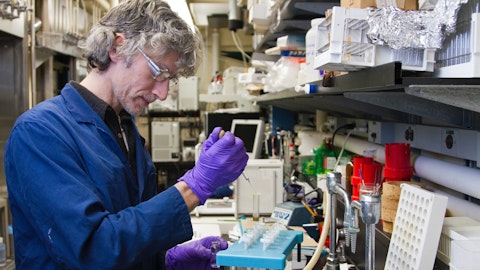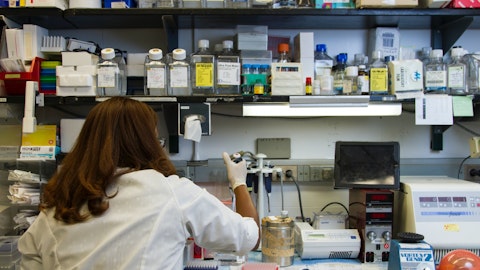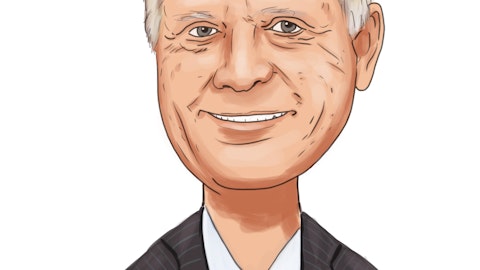Etzer Darout: Got it. Great. Thank you.
Operator: Thank you. [Operator Instructions] Our next question comes from the line of Charles Zhu from Guggenheim Securities. Your line is now open.
Unidentified Analyst: Hey, guys. This is Rosie on for Charles. Thanks for taking our questions and congrats on all the progress. So I have two questions regarding vudalimab. So in the frontline non-small cell and cancer setting, could you maybe comment on how vudalimab is compensated from the competitor bispecific? And then for the monotherapy setting, you provided guidance to data for the prostate cohort in early 2024. Could you maybe talk a little bit regarding how you are setting expectations for that data readout?
Bassil Dahiyat: So I’ll take the second one first, and then Nancy, you can want to take one on the frontline lung. So we are going to have a greater end that we’re going to report. So we’ve reported relatively small numbers of patients out of the trial so far, and we haven’t reported any out of the monotherapy trial. So we’re just going to – really it’s about increasing the numbers so we can zero people in on where we think the strongest potential is of the various cohorts in our combo study as well as in the monotherapy. And in terms of setting expectations, I think the landscape is shifting a lot in prostate cancer. I think we’re certainly very aware of the xaluritamig data from Amgen in a similar line of therapy, showing a 41% OR, obviously, very excited because we made the thing, but also mindful of that.
And so I think we’re looking at a bar that might be shifting a little bit. And just this is about us determining where we follow relative to that bar with a higher number of patients. So I don’t think we can offer too much more than that.
Nancy Valente: And I think you asked about differentiating from our competitor or competitors? Yes. And so John can also, I guess, chime in here, but vudalimab was designed specifically and optimized to have reduced potency in some ways to be very effective, but also to be very tolerable as far as toxicity goes. The idea is that it would bind to duly bind to T-cells that have both expressed and these are in the tumor itself versus the circulation. The data so far when we compared our data to some of the competitors, it’s a little bit hard. But when we look at – when we try to look at Phase 1 or dose escalation compared to dose escalation, what we saw was – we have very heavily pretreated patients that are checkpoint failed or experienced.
And our competitors often have checkpoint-naive patients. So it’s very hard to do that apples-to-apples comparison. But even with that, by doing so, when we looked at the efficacy across products and the safety, we thought we had something that was probably similar and likely to be less toxic as we moved it into earlier settings. So that’s what – that’s how I would summarize the differentiation.
Unidentified Analyst: Great. Thank you. And maybe just a follow-up on XmAb564, is there – can you provide any color on how enrollment has progressed with the multiple ascending dose study?
Bassil Dahiyat: The enrollment is really not – it’s a relatively small study, the number of patients, relatively small. Enrollment is not really the driver of the timeline at all, it’s the escalation safety windows that you have to wait through to go to the next dose level in the next cohort in the multiple ascending dose.
Unidentified Analyst: Alright. Thank you.
Operator: Thank you. [Operator Instructions] Our next question comes from the line of Gregory Renza from RBC Capital Markets. Your line is now open.
Unidentified Analyst: Hi, thank you so much for taking all questions. This is [indiscernible] on for Greg. I have a question on the T-cell engager. I am just curious if you can talk about the learning from xaluritamig data, particularly on the adverse events. I’m just curious if you think the adverse event is within the acceptable and expected level for the class and if that’s something that you can do to mitigate that for your study? Thank you.
Bassil Dahiyat: Yes, I’ll take that. I think it’s – the adverse events they saw, I think, are redeemed certainly by Amgen quite within the range of acceptable. They’re aggressively expanding the program. I think one of the things they’re going to have to work on, and I think they’re well positioned is educating a new community of oncologists about T-cell engagers and cytokine release syndrome. This is the prostate cancer community. They’re not used to it. They’re not used to IRAEs because they’re not used to checkpoints, but I think they’ll get there. I think we’ve seen these kinds of adoption of highly active agents work its way through the oncology community when we saw ADC start to emerge about 4 or 5 years ago, more broadly.
So I think it’s well within the range. And we saw, the learnings we saw from them were really nothing new. It’s you use priming doses and step-ups. You have to be thoughtful about optimizing them. And one of the things they did is they adopted a somewhat more aggressive premedication routine before the infusions while they’re stepping up the doses when they’re jumping from a prior dose being lower to the next one higher. And that’s just the usual premedication people have done with Rituxan for decades a Tylenol, Benadryl and then a corticosteroid, they just intensified that someone that had a big impact. So those are the kind of things we’re considering and being very aware of. Anything to add there, Nancy?
Nancy Valente: I agree. I think it’s – this class of drugs does have cytokine release that’s expected. And I think as people get more comfortable managing it, it won’t be a deal breaker. The efficacy is really strong. And you have to remember, these are patients that are multiply pretreated. Say a median of four prior therapies, yes. So to see a response rate like they saw 41%. It’s pretty amazing for these kind of patients. And so it’s great to see this and other CD3s moving forward and showing this kind of activity because it shows that by T-cell engaging bispecifics are going to have a role in the treatment of solid tumors, which is very exciting for patients as well.
Unidentified Analyst: Thank you so much.
Operator: Thank you. [Operator Instructions] Our next question comes from the line of Alec Stranahan from Bank of America. Your line is now open.
Alec Stranahan: Hey, guys. Thanks for taking our questions. Just a couple from us. One more on AMG 509. We’ve heard some differences in opinion on PSA50 reductions as a good surrogate for response, although it seems consistent in the five patients that the maximally tolerated dose. So any thoughts on PSA50, how we should be thinking about that in terms of response. And then I’ve got a follow-up.



